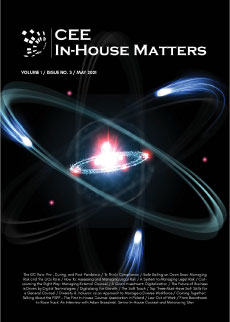Marta Ziolkowska-Nasinska, Regional Legal Counsel at Ferrero, offers insights into her company’s Diversity & Inclusion project.
CEEIHM: What do diversity and inclusion mean to you?
Marta: Diversity matters. It has been confirmed that diversity drives better business results. Diverse teams show more creativity and are more inclined to innovate, while retaining people and boosting their company’s image. Today’s international expansion requires a new pace and direction, engaging all of us to create a more diverse and inclusive work environment, where all people, regardless of their background, have equal access to opportunities and resources. Because all people are talented in their own ways.
What I find particularly important is that diversity is about a mix. Diversity without inclusion does not work, however. It is the inclusion that unleashes the power of diversity, and makes the mix work.
CEEIHM: Tell us a bit about Ferrero’s approach to diversity and inclusion.
Marta: Ferrero is committed to building a diverse and inclusive culture in which all employees feel welcomed and appreciated and have equal opportunities. With our expansion to other continents, our workforce became more and more diverse, and Ferrero wanted its diversity to be a strengthening element. As a result of internal analysis, the Diversity and Inclusion project was started at the headquarters level in order to identify areas for improvement. Four basic dimensions were defined on which the company would further focus: gender, nationalities, generations, and working culture. These were linked to several UN Sustainable Development Goals – number 5 - gender equality; number 8 - decent work and economic growth; and number 10 - reduced inequalities – which are considered a compass to define global priorities and aspirations for 2030. A dedicated project team worked on identifying key performance indicators and initiatives to move our company from “as is” to “to be.” One such initiative was the appointment of 17 Ambassadors that established a global network of D&I Ambassadors who chair and facilitate Regional D&I Councils.
CEEIHM: When were the Councils established and what is their purpose?
Marta: The project was implemented globally in 2020. The D&I Councils are composed of 130 people of 25 nationalities representing a cross-section of departments, positions, ages, and genders. Their task is to promote and adapt the vision of the project at Ferrero’s local structures around the world. In Poland, there are 12 members of the Council.
CEEIHM: What is the structure of the Council in Poland and what is your role within it?
Marta: We made D&I an organizational priority rather than simply an HR priority. Our D&I Council includes seven women and five men that represent four different nationalities and ten different departments. So far, our representation included Boomers, Generation X, and Millennials, whose work experience at Ferrero ranged from a few to as much as 37 years.
To create and promote an inclusive work environment, every organization must start with “the tone from the top.” Ferrero’s senior leaders, including four members of the management board, show commitment and promote the Initiative by being part of the Council and by actively participating in its work. I was happy to receive an invitation to join the Council, an invitation that I see as an example of the D&I approach as well as recognition of the steps the legal department at Ferrero makes towards the creation of a more inclusive work environment in the legal industry.
CEEIHM: How does Ferrero promote diversity and inclusion among its workforce?
Marta: At Ferrero, we increase our employees’ awareness of and engagement in the D&I program. A special platform dedicated to D&I was created and each employee can learn about the program and the goals identified by the company. Every employee who wants to contribute his or her ideas and energy to the implementation of the D&I program is welcome to apply for cooperation. We also celebrate World Day for Cultural Diversity on May 21.
Ferrero puts effort into onboarding actions to make sure that our newcomers have an inclusive and successful onboarding experience and can start building their network to feel included from the first day (for example, the “Buddy Program” for newcomers).
We have also developed D&I-focused learning tools like the online cultural intelligence tool or D&I training that is mandatory for all employees. In addition, we pay attention to our leaders, as they are expected to be role models for best practices, and we have designed learning modules and objectives especially for them.
One of our latest initiatives is the revision of the guidelines on office and remote working practices. Flexible working and remote working guidelines are expected to foster productivity and employee satisfaction.
CEEIHM: Which part of this work do you enjoy the most?
Marta: During our D&I Council meetings we discuss and share practices related to diversity and inclusion. That gives me the opportunity to hear arguments from colleagues of different ages, work experience levels, and backgrounds. I find those discussions very interesting as they provide me with a different perspective and help me see issues from a different angle.
CEEIHM: In your experience, what are some of the best methods for a company to cultivate diversity and inclusion within its ranks?
Marta: It starts with attracting diverse candidates. Companies should ensure that their assessment and selection process is inclusive of underrepresented groups, is bias-free, and that the most competent talents are hired and retained. It is also about constant education, communication, and awareness campaigns about diversity and inclusion as well as the creation of cross-communication tools and solutions (like, for instance, mentoring programs).
By Djordje Vesic
This article was published in issue 1.3 of CEE In-House Matters. The full edition is available here in pdf format, here in e-reader format, and here in electronic format.


